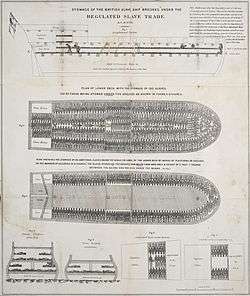Brookes (ship)

The Brookes was a British slave ship of the 18th century that became infamous after prints of her were published in 1788.
An engraving first published in Plymouth in 1788 by the Plymouth chapter of the Society for Effecting the Abolition of the Slave Trade depicted the conditions on board the Brookes[1] and has become an iconic image of the inhumanity of the slave trade.
The image portrayed slaves arranged on the ship's lower deck and poop deck, in accordance with the Regulated Slave Trade Act of 1788.[2] The Brookes was reportedly allowed to stow 454 African slaves, by allowing a space of 6 feet (1.8 m) by 1 foot 4 inches (0.41 m) to each man; 5 feet 10 inches (1.78 m) by 1 foot 4 inches (0.41 m) to each women, and 5 feet (1.5 m) by 1 foot 2 inches (0.36 m) to each child. However, the poster's text alleges that a slave trader confessed that before the Act, the Brookes had carried as many as 609 slaves at one time.[3]
In July 2008, students and staff at Durham University in northeast England re-created the image of the Brookes print to draw attention to the atrocities of the middle passage, in an exercise that involved lying on the ground in a manner similar to the slaves arranged on the Brookes.[4][1]
References
- 1 2 "The Brookes - visualising the transatlantic slave trade". 1807 Commemorated: The abolition of the aslave trade. Institute for the Public Understanding of the Past. 2007. Retrieved 11 March 2016.
- ↑ "Stowage of the British slave ship "Brookes" under the regulated slave trade act of 1788. [n. p. n. d.]. -- Piece 1 of 1,". An American Time Capsule: Three Centuries of Broadsides and Other Printed Ephemera. The Library of Congress. Retrieved 10 March 2016.
- ↑ "Stowage of the British slave ship "Brookes" under the regulated slave trade act of 1789. [n. p. n. d.].". Retrieved 11 March 2016.
- ↑ "Palace Green transformed into a slave ship". Durham First. Durham University. Retrieved 17 July 2011.